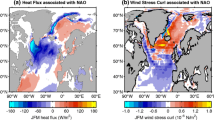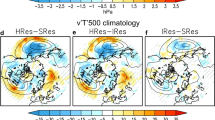Abstract
A century scale integration of a near-global atmosphere–ocean model is used to study the multi-decadal variability of the thermohaline circulation (THC) in the Atlantic. The differences between the coupled and two supplementary ocean-only experiments suggest that a significant component of this variability is controlled by either a collective behavior of the ocean and the atmosphere, particularly in the form of air-sea heat exchange, or sub-monthly random noise present in the coupled system. Possible physical mechanisms giving rise to the mode of this THC variability are discussed. The SST anomaly associated with the THC variability resembles an interdecadal SST pattern extracted from observational data, as well as a pattern associated with the 50–60 year THC variability in the GFDL coupled model. In each case, a warming throughout the subpolar North Atlantic but concentrated along the Gulf Stream and its extension is indicated when the THC is strong. Concomitantly, surface air temperature has positive anomalies over the warmer ocean, with the strongest signal located downwind of the warmest SST anomalies and intruding into the western Eurasian Continent. In addition to the thermal response, there are also changes in the atmospheric flow pattern. More specifically, an anomalous northerly wind develops over the Labrador Sea when the THC is stronger than normal, suggesting a local primacy of the atmospheric forcing in the thermohaline perturbation structure.
















Similar content being viewed by others
References
Ambaum MHP, Hoskins BJ, Stephenson DB (2001) Arctic Oscillation or North Atlantic Oscillation? J Clim 14: 3495–3507
Bleck R, Smith LT (1990) A wind-driven isopycnic coordinate model of the north and equatorial Atlantic Ocean. 1. Model development and supporting experiments. J Geophys Res 95C: 3273—3285
Bleck R, Rooth C, Hu D, Smith LT (1992) Salinity-driven thermocline transients in a wind and thermohaline-forced isopycnic coordinate model of the North Atlantic. J Phys Oceanogr 22: 1486–1505
Bonan GB (1996) A land surface model (LSM version 1.0) for ecological, hydrological, and atmospheric studies) technical description and user’s guide. NCAR Technical Note, Boulder, Colorado, USA, pp 150
Bryan FO (1986) High-latitude salinity effects and interhemispheric thermohaline circulations. Nature 323: 301–304
Cai W, Greatbatch RJ, Zhang S (1995) Interdecadal variability in an ocean model driven by a small, zonal redistribution of the surface buoyancy flux. J Phys Oceanogr 25: 1998–2010
Chassignet EP, Smith LT, Bleck R, Bryan FO (1996) A model comparison: numerical simulations of the North Atlantic ocean circulation in depth and isopycnic coordinates. J Phys Oceanogr 26: 1849–1867
Cheng W (2000) Climate variability in the North Atlantic on decadal and multi-decadal time scales: a numerical study. http://oceanmodeling.rsmas.miami.edu/micom/micom-refs.htmlPhD dissertation. University of Miami, FL, USA, pp 153
Curry RG, McCartney MS, Joyce TM (1998) Oceanic transport of subpolar climate signals to mid-depth subtropical waters. Nature 391: 575–577
Delworth TL, Dixon KW (2000) Implications of the recent trend in the Arctic/North Atlantic Oscillation for the North Atlantic thermohaline circulation. J Clim 13: 3721–3727
Delworth TL, Greatbatch RJ (2000) Multi-decadal thermohaline circulation variability driven by atmospheric surface flux forcing. J Clim 13: 1481–1495
Delworth TL, Manabe S, Stouffer RJ (1993) Interdecadal variations of the thermohaline circulation in a coupled ocean-atmosphere model. J Clim 6: 1993–2011
Döös K, Webb DJ (1994) The Deacon cell and the other meridional cells of the Southern Ocean. J Phys Oceanogr 24: 429–442
Fine RA (1995) Tracers, time scales, and the thermohaline circulation: the lower limb in the North Atlantic Ocean. Rev Geophys 33: 1353–1365
Frankignoul C (1985) Sea surface temperature anomalies, planetary waves and air-sea feedback in the middle latitudes. Rev Geophys 23: 357–390
Greatbatch RJ, Zhang S (1995) An interdecadal oscillation in an idealized ocean basin forced by constant heat flux. J Clim 8: 81–91
GSP Group (1993) Greenland Sea project. Eos, Trans Am Geophys Union 71(24): 750–755
Griffies SM, Pacanowski RC, Hallberg RW (2000) Spurious diapycnal mixing associated with advection in a z-coordinate ocean model. Mon Weather Rev 128: 538–564
Guilyardi E, Madec G (1997) performance of the OPA/ARPEGE-T21 global ocean-atmosphere coupled model. Clim Dyn 13: 149–165
Hack JJ (1994) Parameterization of moist convection in the National Center for Atmospheric Research Community Climate Model (CCM2). J Geophys Res 99: 5551–5568
Hallberg RW, Rhines PB (1996) Buoyancy-driven circulation in an ocean basin with isopycnals intersecting the sloping boundary. J Phys Oceanogr 26: 913–940
Hogg NG, Stommel H (1985) On the relation between the deep circulation and the Gulf Stream. Deep-Sea Res 32: 1181–1193
Huang RX, Cane MA, Naik N, Goodman P (2000) Global adjustment of the thermohaline in response to deep water formation. Geophys Rev Lett 27: 759–762
Joyce TM, Robbins PE (1996) The long-term hydrographic record at Bermuda. J Clim 9: 3121–3131
Kawase M (1987) Establishment of deep ocean circulation driven by deep-water production. J Phys Oceanogr 17: 294–2317
Kiehl JT, Hack JJ, Bonan GB, Boville BA, Briegleb BP, Williamson DL, Rasch PJ (1996) Description of the NCAR Community Climate Model (CCM3). NCAR Technical Note, Boulder, Colorado, USA, pp 152
Kraus EB, Turner JS (1967) A one-dimensional model of the seasonal thermocline. Part 2, the general theory and its consequences. Tellus 19: 98–106
Kushnir Y (1994) Interdecadal variations in North Atlantic sea surface temperature and associated atmospheric conditions. J Clim 7: 141–157
Lab Sea Group (1998) The Labrador Sea deep convection experiment. Bull Am Meteorol Soc 79: 1033–2058
Lazier JRN (1988) Temperature and salinity changes in the deep Labrador Sea, 1962–1986. Deep-Sea Res 35(8): 1247–1253
Lenderink G, Haarsma RJ (1994) Variability and multiple equilibria of the thermohaline circulation associated with deep-water formation. J Phys Oceanogr 24: 1480–1493
Levitus S (1994) World ocean atlas 1994 CD-rom sets. National Oceanographic Data Center Informal Report
Manabe S, Stouffer RJ (1988) Two stable equilibria of a coupled ocean-atmosphere model. J Clim 1: 841–866
Manabe S, Stouffer RJ (1995) Simulation of abrupt climate change induced by freshwater input to the North Atlantic Ocean. Nature 378: 165–167
Marotzke J, Willebrand J (1991) Multiple equilibria of the global thermohaline circulation. J Phys Oceanogr 21: 1372–1385
Marotzke J, Scott JR (1999) Convective mixing and the thermohaline circulation. J Phys Oceanogr 29: 962–2970
Mauritzen C, Häkkinen S (1999) On the relationship between dense water formation and the “Meridional Overturning Cell” in the North Atlantic ocean. Deep-Sea Res 46: 877–894
McDougall TJ, Dewar WK (1998) Vertical mixing and cabbeling in layered models. J Phys Oceanogr 28: 1458–1480
Mikolajewicz U, Maier-Reimer E (1990) Internal secular variability in an ocean general circulation model. Clim Dyn 4: 145–156
Nakamura M, Stone PH, Marotzke J (1994) Destabilization of the thermohaline circulation by atmospheric eddy transports. J Clim 7: 1870–1882
Palmer TN, Sun Z (1985) A modeling and observational study of the relationship between sea surface temperature in the northwest Atlantic and the atmospheric general circulation. Q J R Meteorol Soc 111: 947–975
Peng SL, Mysak LA, Derome J, Ritchie H, Dugas B (1995) Two differences between early and midwinter atmospheric responses to sea surface temperature anomalies in the northwest Atlantic. J Clim 8: 137–157
Pickart RS, Torres D, Lavender K (2000) Is Labrador Sea water formed in the Irminger basin? EOS, Trans Am Geophys Union 80: 536
Reid JL (1986) On the total geostrophic circulation of the South Pacific Ocean: flow patterns, trancers and transports. Prog Oceanogr 16: 1–61
Rooth CG (1982) Hydrology and the ocean circulation. Prog Oceanogr 11: 131–149
Saravanan R (1998) Atmospheric low-frequency variability and its relationship to midlatitude SST variability: studies using the NCAR Climate System Model. J Clim 6: 1386–1404
Sausen R, Barthel K, Hasselmann K (1988) Coupled atmosphere models with flux correction. Clim Dyn 2: 145–163
Schmitt RW, Bogden PS, Dorman CE (1989) Evaporation minus precipitation and density fluxes for the North Atlantic. J Phys Oceanogr 19: 1208–1221
Send U, Marshall J (1993) Integral effects of deep convection. J Phys Oceanogr 23: 855–872
Smagorinsky JS (1963) General circulation experiments with the primitive equations. I. The basic experiment. Mon Weather Rev 91: 99–164
Spall MA (1996) Dynamics of the Gulf Stream/Deep Western Boundary Current crossover. Part 2: Low-frequency internal oscillations. J Phys Oceanogr 26: 169–2182
Stommel H (1961) Thermohaline convection with two stable regimes of flow. Tellus 13: 24–230
Stommel H, Arons AB (1960) On the abyssal circulation of the world ocean-1. Stationary planetary flow patterns on a sphere. Deep-Sea Res 6: 140–154
Thompson JD, Schmitz Jr WJ (1989) A limited-area model of the Gulf Stream: design, initial experiments, and model-data intercomparison. J Phys Oceanogr 19: 791–814
Thompson DWJ, Wallace JM (2000a) Annular modes in the extratropical circulation. Part 1. Month-to-month variability. J Clim 13: 1000–1016
Thompson DWJ, Wallace JM (2000b) Annular modes in the extratropical circulation. Part 2. Trends. J Clim 13: 1018–1036
Timmermann A, Latif M, Voss R, Grötzner A (1998) Northern hemispheric interdecadal variability: a coupled air-sea mode. J Clim 11: 1906–1931
Trenberth KE, Caron JM, Stepaniak DP (2001) The atmospheric energy budget and implications for surface fluxes and ocean heat transports. Clim Dyn 17: 59–276
von Storch J, Müller P, Stouffer RJ, Voss R, Tett SFB (2000) Variability of deep-ocean mass transport: spectral shapes and spatial scales. J Clim 13: 1916–1935
Weaver AJ, Sarachik ES (1991a) The role of mixed boundary conditions in numerical models of the ocean’s climate. J Phys Oceanogr 21: 1470–1493
Weaver AJ, Sarachik ES (1991b) Evidence for decadal variability in an ocean general circulation model: an advective mechanism. Atmos Ocean 29: 197–231
Weaver AJ, Valcke S (1998) On the variability of the thermohaline circulation in the GFDL coupled model. J Clim 11: 759–767
Weaver AJ, Marotzke J, Cummins PE, Sarachik ES (1993) Stability and variability of the thermohaline circulation. J Phys Oceanogr 23: 39–60
Winton M, Sarachik ES (1993) Thermohaline oscillations induced by strong steady salinity forcing of ocean general circulation models. J Phys Oceanogr 23: 1389–1410
Zhang GJ, McFarlane NA (1995) Sensitivity of climate simulations to the parametrization of cumulus convection in the Canadian Climate Center General Circulation Model. Atmos Ocean 33: 407–446
Acknowledgements
This work was sponsored by the US Department of Energy CHAMMP and CCPP programs under Grant DE-FG02-98ER62608. Computations were carried out at the Los Alamos National Laboratory and at the National Center for Atmospheric Research (NCAR). NCAR is sponsored by the National Science Foundation.
Author information
Authors and Affiliations
Corresponding author
Rights and permissions
About this article
Cite this article
Cheng, W., Bleck, R. & Rooth, C. Multi-decadal thermohaline variability in an ocean–atmosphere general circulation model. Climate Dynamics 22, 573–590 (2004). https://doi.org/10.1007/s00382-004-0400-6
Received:
Accepted:
Published:
Issue Date:
DOI: https://doi.org/10.1007/s00382-004-0400-6




